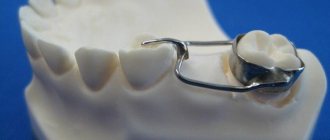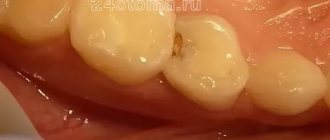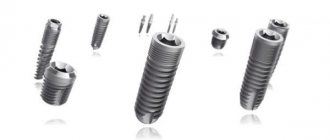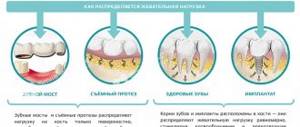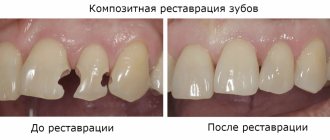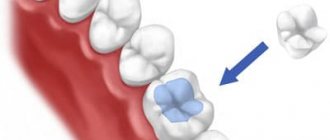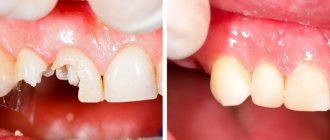In the article Walking Without Teeth... or Prosthetics, we equated the presence of teeth with human health. Be sure to read this article. It tells what health problems the absence of even a few teeth can lead to.
And now we will talk about the restoration of lateral (chewing) teeth.
The function of the lateral teeth is to thoroughly chew (grind) food, therefore, when restoring damaged teeth, you need to make them strong and give them the correct shape!
Look at the intricate pattern of ridges and grooves (fissures) on the surface of your chewing teeth. Do you know why it is necessary to accurately reproduce the original (natural) pattern on a treated tooth?
When grinding food , the teeth experience greater stress and come into contact with opposing teeth (antagonists). In order for the antagonist teeth to connect into the correct bite, but not experience strong friction against each other “during operation,” they must touch at points of a small area (at contact points).
It happens that in order to form a correct bite, the original shape of the teeth requires correction. In this case, an orthodontist is involved in the treatment.
So, the key to a long “service” of chewing teeth is their high strength and connection into the correct bite.
Anchor pin
Models of anchor pins can be grouped:
- According to the fastening method, there are pins with sharp and blunt threads, with a stepped surface;
- According to the material of manufacture - fiberglass, steel, brass, titanium are used;
- Shape: conical and cylindrical.
Anchor pins allow:
- Restore teeth using photopolymers;
- Restore for installation of a crown.
- They are intended for the chewing group, but they can also be installed on the front teeth.
A filling cannot be crowned
Many patients are still wildly afraid of crowns, and persistently ask for another filling to solve the problem.
Our doctors encounter such requests in 70% of consultations. The doctor, of course, can take into account the patient’s request and give him a filling that is good, reliable, and of high quality.
But other statistics show that patients who insist on having a filling installed return to the clinic as soon as possible, but for inlays and crowns.
There are many cases when the wall of a “dead” tooth, restored by filling, breaks off, and the chip goes under the gum, and this leads to tooth loss or removal! In most such cases, the tooth can be saved by protecting it with a crown in time.
As a result, it would be possible to avoid wasting time on visits to the doctor, save nerves and money, if you take into account the recommendations of the attending physician in a timely manner.
Using our patient as an example, let’s consider this situation.
Using a pin - advantages and disadvantages
- A pin embedded in the root of the tooth serves as a strengthening element and an obstacle to destruction.
- According to many dentists, a pin of this type under a crown is harmful, as it requires a significant expansion of the root canal. As a result, the mechanical strength of the root system suffers.
- Installing such a structure can cause a root fracture, resulting in the tooth having to be removed.
- Removing such teeth is a problematic and complex undertaking.
Fiberglass pin:
- Similar to natural dentin;
- Has high plasticity;
- Bonds well with filling material;
- Effective for the restoration of anterior teeth that are not subject to high loads when chewing.
Advantages of using a pin:
- There is no need to prepare a large volume of dentin;
- This is a budget solution;
- Restoration occurs in one visit to the doctor.
Flaws:
- There is no ligament between the root and the crown, their easy separation is possible;
- With poor installation or high chewing load, deformation of the root system and death of surrounding tissues is possible;
- When screwing in the rod, bone tissue may be damaged.
Filling, ceramic inlay or crown – what to install?
Advantages of microprosthetics and other trends in modern dentistry
A ceramic inlay is a ceramic filling that is made to match the color of the tooth in a dental laboratory (baked in a special oven).
This filling does not shrink and restores the full anatomy of the tooth. To make it, special impressions are taken from both jaws, taking into account the individual bite.
The tab is smooth and resembles enamel. Ceramic inlays can be an intermediate step between a regular filling and a crown on a tooth.
Advantages of a ceramic inlay over a conventional filling
- Over time, the filling changes color and shrinks, and secondary caries may appear along the seam;
- There is less plaque on the ceramic inlay;
- the onlay looks aesthetically harmonious with the rest of the teeth;
- The service life of the tab is more than 5 years, the official guarantee for a regular filling is 1 year
When to install a ceramic onlay
It can be technically difficult to place a filling on distant teeth – for example, because:
- a person cannot open his mouth wide;
- the oral cavity is small;
- large tongue;
- increased salivation;
- complex shape of the cavity after cleaning from caries.
Minuses:
- A ceramic filling is several times more expensive than a regular filling.
Modern filling materials
Dentistry is constantly evolving, one of the trends and tasks of modern dentistry is the constant improvement of filling materials in order to increase their service life. Advantages of modern filling materials over materials of the previous generation:
- improved connection with tooth tissue;
- increased degree of adhesion;
- thin connecting material;
- less risk of developing secondary caries;
- less porous, and therefore more durable;
- expanded color range;
- are better polished: a smoother surface is less likely to fix plaque.
Causes of fillings falling out: the importance of vitamin D
Fillings can fall out for various reasons: poor quality work by the dentist, cheap materials, expiration of the filling’s service life, improper use, but the most common reason is thinning and destruction of the walls of the tooth on which the filling is installed.
Recently, the poor condition of teeth is primarily due to a lack of vitamin D. It is this that delivers calcium to all tissues of the body, including teeth and bones. In our northern latitudes, this occurs due to a lack of sunlight, which accumulates the production of vitamin D in the body.
Prevention of vitamin D deficiency:
- healthy lifestyle;
- good nutrition;
- regular holidays in sunny countries.
Pregnant and breastfeeding women are at particular risk. Currently, there is a tendency for teeth to decay in women precisely during these periods, and the condition of teeth improves significantly after prescribing and taking a vitamin-mineral complex with a high content of vitamin D.
The dentists of the DomodenT clinic always try to give comprehensive recommendations to the patient, since in many cases only complex treatment leads to the desired result.
Commenting system SigComments
Back to section
Tabs
This is a type of permanent prosthetics. The inlays have the appearance of a molar. Most often used on the chewing group of teeth. Can serve as a support for a bridge prosthesis.
Tabs are:
- Solid cast, non-separable – for a single-rooted tooth;
- Collapsible - for two and three-rooted teeth, includes basic elements and locking pins.
You can put a tab on a zirconium base. Metal-free ceramics have a degree of transparency close to natural dentin. The structure is fastened using composite mass.
Stump inlays in each individual case are made individually using metal casting.
Manufacturing procedure:
- The required area is prepared;
- An impression is made from silicone mass;
- The finished product is cast in the laboratory.
- An orthopedic dentist will place a stump on the tooth.
Indications for therapeutic filling
Restoration with a filling is known to everyone, and dentistry is usually associated with this procedure. Indeed, very often filling is used to restore the anatomical structure of the coronal part. But not every tooth can be effectively restored with cement.
In order to properly install a filling, several local conditions must exist:
- Small size of destruction . Filling can be rational if the loss of hard tissue volume is no more than 50%. Since dental cement always requires support from natural enamel and dentin.
- Absence of subgingival caries . If the carious process has spread along one of the walls of the crown to the area of the enamel-cement border and below, cementing the defect will be impossible. This is due to the fact that in conditions of work under the gum level it is impossible to create acceptable tightness and dryness of the working field. Such a filling will not hold, will certainly collapse and will lead to further destruction of the root, which will lead to removal.
- Good cavity wall thickness . In order for the cement to protect the tooth and not further destroy it, each of the walls of the prepared cavity must have a thickness of at least 2 mm. Otherwise, constant chewing pressure directed vertically will lead to breakage of the wall.
If all these conditions are met, you don’t have to think long about whether you need a crown or a filling. A regular therapeutic filling will perfectly replace a small defect and prolong the life of the tooth.
Which is better to choose?
The choice is made by the dentist based on the advantages and disadvantages of each option.
General conditions for the use of plug-in structures:
- Before installation, the tooth is depulped and the canals are filled;
- High-quality canal treatment reduces the risk of relapse to zero;
- The preparatory measures in each case are carried out in the same way, the same tools are used.
The advantage of using a pin is that manufacturing using an indirect method increases the likelihood of obtaining a durable product. The pin allows restoration of any group of teeth.
Flaws:
- Complex installation;
- Long production time.
A case from our practice
The patient, on recommendation, came to our dentistry for treatment. Previously, in another clinic, one of the chewing teeth was restored with the help of an impressive filling. The “BEFORE” picture shows the filling during the first visit to NOVODENTA+, 1 year after it was placed.
The strong chewing load and the scale of the filling itself led to a loss of tooth aesthetics and partially affected the bite.
And here we are talking about another advantage of crowns - they are made from impressions in the clinic’s own laboratory, and the filling is placed directly in the mouth. The filling cannot completely reproduce the anatomy of the tooth and therefore the patient may experience discomfort, additional stress on the TMJ and, as a result, pain.
Pin
A dental pin is a rod designed to strengthen a decayed or dilapidated tooth . The device is installed in the root zone or directly into the dentin, and a hardening mass is built up on top. The main function of the pin is to strengthen the entire tooth so that it does not break under load on the filling or the extended part.
There are two types of pins:
- Metal (titanium, brass, palladium, steel, gold (with impurities).
- Non-metallic (fiberglass, ceramics, carbon fiber).
The shape of the device is conical, cylindrical, cylindrical, screw.
According to the method of fixation, the pins are divided into:
- Active - a solid rod has a special thread with which it is screwed into the dental tissue. This type of pin is used to restore a completely or almost completely destroyed tooth, since when used, a strong load is created that can cause the tooth to split.
- Passive - the rod is fixed in the root canal using a special reinforcing material. This type is used to strengthen the tooth after treatment.
Indications for installation: half-destroyed or completely missing natural dental crown, creation of support when installing removable and fixed dentures.
Contraindications: diseases of the blood and nervous system, inflammatory pathologies of the oral cavity, caries, cysts in the oral cavity, root length is less than the planned crown height, root walls are too thin ( less than 2 mm ).
Stages of installing a crown on a pin
- Initial consultation, determination of indications and contraindications for treatment.
- Preparation of tooth tissues and depulpation of root canals.
- Installation of the pin.
- Taking impressions or 3D modeling. Sending the results to the laboratory to make a permanent crown. Immediately after the procedure, the patient is offered a temporary crown.
- Trying on the finished product and fixing the crown with a pin.
Dental crown
An alternative method for restoring a damaged tooth is a structure that is placed on a previously ground down tooth.
Its advantages are considered:
- reliability of fixation and protection of the preserved tooth;
- reliable protection of enamel from external bacteria;
- the crown completely copies the shape of a natural tooth without nicks or protrusions, which allows you to preserve the chewing function.
Among the disadvantages it is worth noting:
- the structure of the crown is more rigid and different from a natural tooth, which the patient feels;
- It is possible that the gums may be displaced under the influence of a foreign object – a crown.
Therefore, the feeling of discomfort must be eliminated with the help of additional grinding.
If this measure is not effective enough to restore the tooth, it is possible to install a crown with a pin. This design is considered the most reliable and durable. The pin strengthens the remains of the tooth, and the crown protects against the penetration of bacteria.
Differences
Typically, crowns are much stronger than fillings. The only exceptions are structures made of plastic.
If the filling material falls out, the tooth will require repeated treatment, which cannot be said in the case of an installed crown, which can be reinstalled at any time in the absence of external damage.
Fixing crowns takes much longer than the filling process.
Crowns allow you to ideally restore the lost shape of a tooth, while using a filling it is not always possible to achieve this result.
Alveolitis
There is no need to rush to remove a decayed tooth. Dentists recommend restoration at the slightest opportunity. Even if you managed to save a small fragment or only the root. Otherwise, there is a threat of alveolitis - a disease of the processes on which the teeth are held. They are called alveoli.
When the wound left after tooth extraction is still open, the alveoli are practically not protected from external infections. In the infected socket of the extracted tooth, the blood thickens, the pain quickly intensifies, the temperature soars to 39 degrees, the wound festers, and the smell of the mouth deteriorates. You can avoid these troubles if you replace the removal of the problematic tooth with restoration using a crown or pin.
